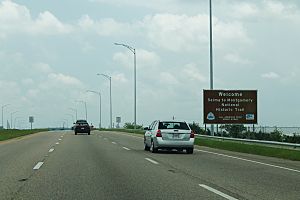Selma to Montgomery National Historic Trail facts for kids
Quick facts for kids Selma to Montgomery National Historic Route |
|
|---|---|
 |
|
| Length | 54 mi (87 km) |
| Surface | Asphalt |
The Selma to Montgomery National Historic Trail is a special path in Alabama. It's about 54 miles (87 km) long. This trail remembers a very important journey from 1965. People marched from Selma to Montgomery to support equal voting rights for everyone.
Contents
History of the Selma to Montgomery March
The Selma to Montgomery March happened from March 21 to 25, 1965. It was led by Dr. Martin Luther King Jr.. This march was the final part of several weeks of efforts. People had tried to march before but were stopped by police. About 25,000 people joined the march. It became a huge event in the Civil Rights Movement. The march helped lead to the Voting Rights Act of 1965. This law made sure all citizens could vote fairly. The march showed everyone the unfairness faced by African Americans when they tried to vote.
In 1996, the trail became a National Historic Trail. President Bill Clinton suggested this, and Congress agreed. The National Park Service now helps protect and care for the trail.
Remembering the March: Anniversaries
In March 2005, people re-enacted the march to celebrate its 40th anniversary. This event also led to a special walking path being created around Selma.
In 2015, a new path called the Marion to Selma Connecting Trail was added. It links the main trail to the place where Jimmie Lee Jackson was killed.
Exploring the Historic Trail Route
The Selma to Montgomery National Historic Trail is the shortest of the National Historic Trails. It is 54 miles (87 km) long.
The trail begins at the Mount Zion AME Zion Church in Marion. Signs guide people from Marion to Selma. In Selma, there is a special center to learn about the trail. After visiting, the trail continues to the famous Edmund Pettus Bridge.
The trail then follows U.S. Route 80 to White Hall. Here, you can find the Lownes Interpretive Center. The trail stays on US Highway 80 until it reaches Montgomery, the state capital.
Important Stops Along the Way
Markers along the route show where marchers camped. They also point out other important moments from the march. For example, you can see where Viola Liuzzo was killed. Another marker shows the place in St. Jude's historic district where musicians performed for the marchers. Famous artists like Harry Belafonte, Tony Bennett, and Peter, Paul & Mary played music there.
Besides being a National Historic Trail, this route is also a National Scenic Byway. This means it's a special road known for its beauty and history.
How to Experience the Trail Today
The National Park Service suggests that most people drive the trail. This is because the highway is very busy. Large trucks often pass by quickly.
There is no safe walking path just for people walking between the two cities. The highway is not safe for pedestrians.
Cycling the Historic Route
To remember 55 years since the marches, over 600 cyclists gathered in February 2020. They came from more than 30 states to ride the same route the marchers walked. This was only the second time the route had been cycled as a public event. The first time was in 2015 for the 50th anniversary of the march.



